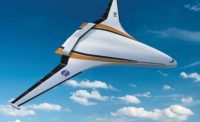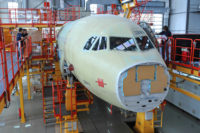Commercial protocols in aerospace applications present designers with the challenge of balancing the standard against the special needs of the application.
In the physical layer, the cables used for Gigabit and 10 Gigabit Ethernet, USB, IEEE 1394 and others are a prime example of this balancing act. The standards for these protocols detail electrical and structural requirements for the cables. One goal of standards is to characterize cables with enough specificity that they can be confidently plugged into any application.
For commercial applications, this approach works admirably. However, the additional concerns for aerospace applications lead designers to reconsider this convenient plug-and-play approach. Their primary driver is reducing size and weight at every opportunity in the aircraft. As the amount of data in both aircraft operation and passenger services increases dramatically, so does the number of conductors needed to carry the data. In aggregate, commercial cables make an attractive target for size and weight reductions. At the same time, industry-standard cables may not possess the desired mechanical or environmental performance, especially the demanding requirements for low smoke generation, toxicity and flammability in closed spaces where safe exit may be difficult or impossible.
The Case for Cat Cable
Consider a Cat 5e cable for Gigabit Ethernet. Its typical commercial construction is a 24 AWG solid bare copper conductor with polyethylene insulation and PVC jacket. The ANSI/TIA 568-C.2 standard defines electrical requirements for attenuation, insertion loss, return loss, crosstalk and a host of other criteria. For our purposes, we will focus on insertion loss. This characteristic largely determines allowable cable distances (assuming crosstalk goals are met).
Consider a typical progression in defining a Cat 5e cable for aerospace. Each step tends to increase both attenuation and insertion loss, effectively reducing the allowable cable length. TE Connectivity works closely with aerospace designers to craft cabling that meets the goals of the application protocol and the requirements for size, weight and robustness.
Stranded conductors give greater flexibility in installing and routing cables in space-constrained aircraft. While the 568-C.2 standard recognizes stranded conductors for short patch cords, it specifies solid conductors for backbone needs because of their lower insertion loss. The change from solid conductor to stranded conductor allows for a 20 percent increase in insertion loss, which would result in a 20 percent decrease in the maximum cable run length.
Many aerospace applications specify silver-coated copper alloy conductors because of their high tensile strength. Moving from pure copper to a copper alloy can increase insertion loss by another 10 percent, depending on the cable design.
Smaller conductors save weight, which explains the trend toward 26 AWG and even 28 AWG. Additional size and weight reductions can also be obtained by using thin-wall, lower permittivity dielectrics and tougher jacket materials.
The Case for USB
USB 2.0 and 3.0 applications present the opposite situation from Cat 5e Ethernet applications. Designers want to extend transmission distances beyond the standard 5 meters for USB 2.0. (USB 3.0 does not specify a maximum cable length, but the practical length for commercial cables is 3 meters.) Since USB supports both power and data, designers need to consider both voltage drop in the power line and insertion loss in the data lines. An additional concern is delay time: 26 nanoseconds end-to-end or 5.2 nanoseconds
per meter for the cable in USB 2.0.
Extending data lengths for USB involves both the conductor size and insulation type (as well as whether the insulation is solid or foamed). While a larger conductor can lower insertion loss, velocity of propagation is more critical to meet the delay requirements. High-velocity insulation will allow longer distances without adding to the delay time. Low-density polytetrafluoroethylene (PTFE) and foamed fluorinated ethylene propylene (FEP) offer velocities of propagation about 13 to 25 percent faster than that possible with the polyethylene used in commercial USB cables. Discounting insertion loss for the moment, low-density PTFE or foamed FEP can extend distances to 6.3 meters while still meeting delay time requirements.
The Case for IEEE 1394
IEEE 1394, as a data backbone, is beginning to take hold in the aerospace market. System designers are removing the components that supply power to the end device or sensor. Quadraxial cable constructions that only provide the two data pairs provide the smallest, lightest-weight cable configuration. Depending on the conductor size, maximum cable runs can range from 50 feet to more than 80 feet. Power to the device is then supplied by separate wires appropriately sized to meet input voltage requirements.
Achieving Ruggedness
Insulation and jacket choices also affect the ruggedness of the cable. Standards-compliant cables can be fabricated with a range of polymers to meet special requirements for chemical and fuel resistance, extended temperatures, low outgassing, toxicity, flame characteristics, flexibility and other factors. To meet the demanding smoke, toxicity, flammability and other environmental requirements imposed by aerospace applications, the materials are more expensive than those used in the commercial constructions.
Off the Shelf or Engineered?
While standards such as ANSI/TIA 568 or USB play a valuable role in allowing applications to be deployed in a cookie-cutter fashion, they can be viewed as either mandates or recommendations. For most users, they are mandates. Knowing that a cable meets all Cat 5e specifications carries the assurance it will work within the application guidelines. A longer view, however, is that channel performance trumps component performance: The critical issue is to deliver the signal with the signal integrity required by the receiver. Standards exist to ensure this delivery. Aerospace designers will accept some modification in the performance specifications so long as the overall application requirements are met.
Such cables may be readily available or they may be semi-custom. TE, for example, has extensive experience in creating cables to help meet specific goals. Such experience allows us to balance the various tradeoffs involved in meeting not only high-speed protocol requirements, but the need for smaller, lighter cables that also withstand application hazards.
For more information, call TE Connectivity at 610-893-9800 or visit www.te.com.






